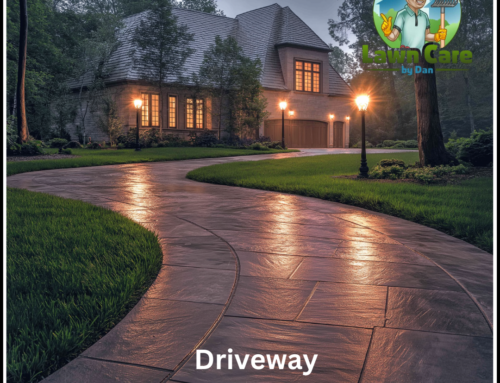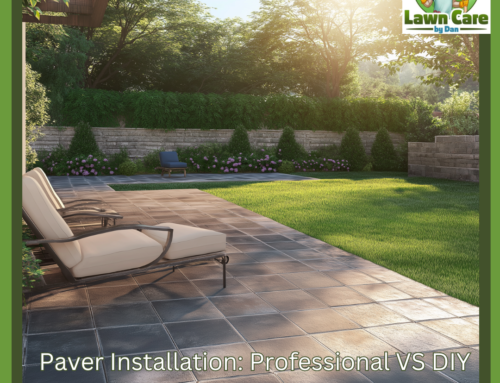Ah, the joy of a well-built paver patio! It’s not just an outdoor space; it’s an extension of your home, a canvas where memories are painted, and a retreat where the day’s stresses melt away. When building that perfect patio, pavers are often the material of choice. Lawn Care By Dan Paver Patios guides you through the nitty-gritty of crafting that dream patio with pavers, ensuring durability, beauty, and functionality converge seamlessly in your outdoor space.
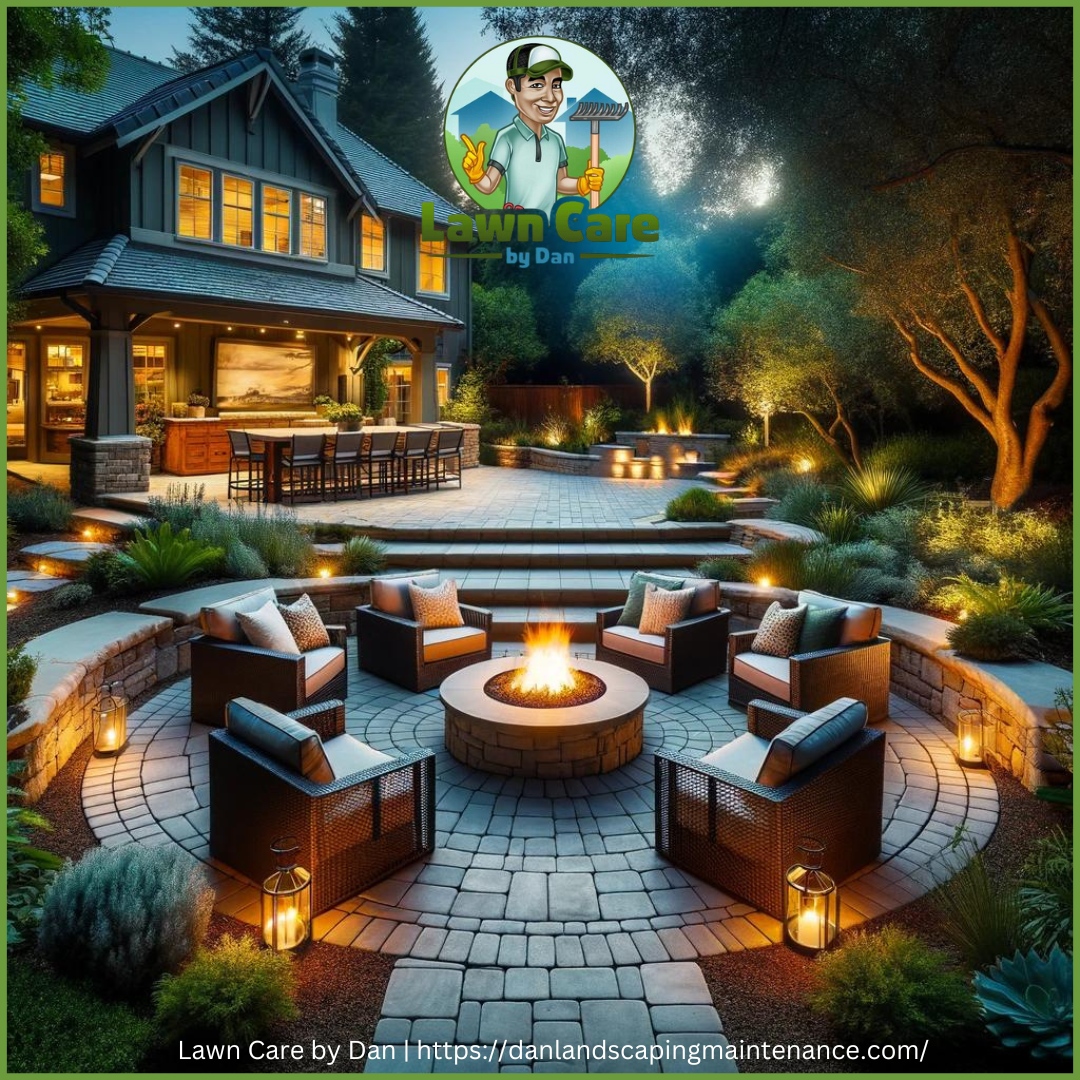
Choosing the Right Paver Materials
When embarking on your patio-building journey with Lawn Care By Dan Paver Patios, choosing material is more than just picking stones; it’s about setting the stage for countless memories. This decision impacts not only the aesthetic appeal of your patio but also its durability, maintenance requirements, and how it ages over time. Let’s delve deeper into the most popular materials for patio pavers and why choosing the right one matters.
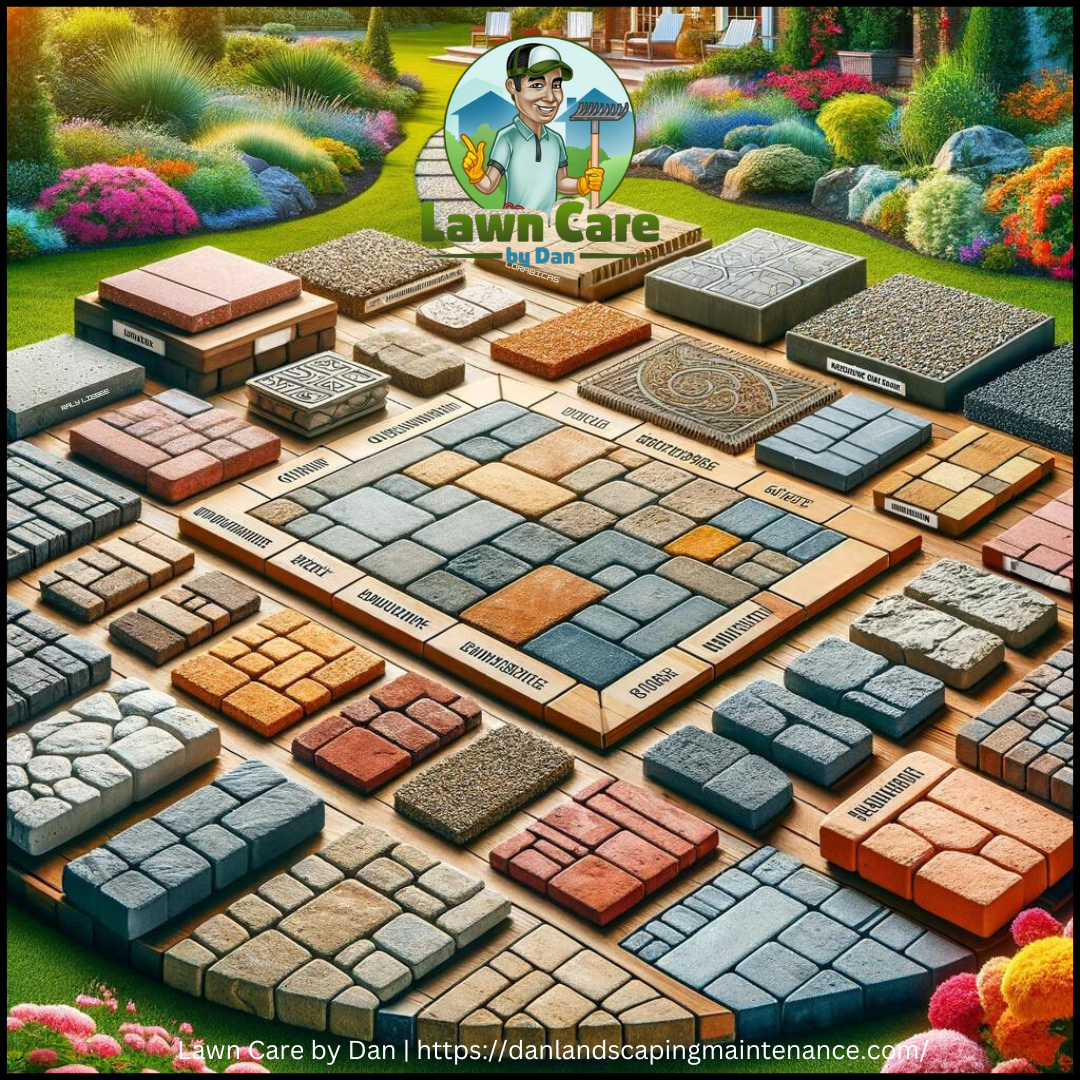
- Concrete Pavers: Concrete pavers are the chameleons of the paver world, and they come in a staggering variety of shapes, sizes, colors, and textures. They can mimic the look of natural stone or brick but at a fraction of the cost. Concrete is known for its durability and ease of installation. However, it’s worth noting that it may be susceptible to cracking in extreme weather conditions and can fade over time if not sealed properly. Concrete pavers offer a pragmatic yet beautiful solution for those seeking versatility and cost-effectiveness.
- Brick Pavers: There’s something timelessly appealing about brick pavers. Their rich, warm tones bring any patio a cozy, inviting atmosphere. Brick is incredibly durable and can last for decades if installed correctly. It also retains its color well, resisting fading from sunlight. However, brick pavers can be more expensive than concrete ones and may require more maintenance, such as regular sealing, to prevent moss and weed growth. Brick pavers are an excellent choice for a classic look that ages gracefully.
- Stone Pavers: For those who desire the utmost natural beauty and uniqueness, stone pavers are unrivaled. Materials like bluestone, flagstone, travertine, and limestone offer unique textures and hues only Mother Nature can provide. Stone pavers blend seamlessly with the natural landscape, creating an elegant, sophisticated outdoor living area. They are incredibly durable and maintain their natural color for years. However, this beauty and durability come at a higher cost regarding the material and installation. Stone pavers may also require more maintenance to keep them looking their best.
Pavers correct for our Pacific Northwest Climate
When choosing materials for your patio pavers, consider the climate in your area. Materials react differently to various weather conditions, and what works in a temperate climate may not be suitable for an area with extreme temperatures. Also, think about the amount of foot traffic your patio will receive. High-traffic areas may benefit from more durable materials that can withstand constant wear and tear.
Beyond practical considerations, think about the overall aesthetic you want to achieve. Your patio should complement the style of your home and garden, creating a cohesive look that enhances your outdoor space. Lawn Care By Dan Paver Patios emphasizes the importance of choosing a material that meets your functional needs and speaks to your style and the ambiance you wish to create.
The suitable material for your patio depends on aesthetic preferences, durability, maintenance, and budget. With Lawn Care By Dan Paver Patios’s expertise, you can make an informed decision that will result in a patio you’ll love for years.
Designing Your Paver Patio Layout
Crafting the perfect patio layout is like painting a masterpiece; it requires vision, careful planning, and attention to detail. We believe a well-thought-out design is the backbone of a patio that meets your functional needs and complements your home’s aesthetic and natural landscape. Here’s a closer look at how to approach designing your patio layout for an enchanting outdoor living space:
- Consider Your Lifestyle: The first step in designing your patio layout is considering how you plan to use the space. Are you dreaming of a cozy nook for intimate gatherings, a vibrant space for entertaining, or a serene retreat for relaxation? Your lifestyle and intended use will guide the design, helping you determine your patio’s size, shape, and features.
- Connect with Your Home’s Architecture: Your patio should be a natural extension of your home, not an afterthought. Consider the architectural style of your house and aim to complement it with your patio design. For instance, a modern home might pair well with clean, geometric lines and minimalistic paver styles, while a traditional home may benefit from the warmth and charm of brick pavers and curved edges.
- Play with Shapes and Sizes: Gone are the days when patios were confined to simple rectangles or squares. Incorporating various shapes and sizes can add visual interest and define different functional areas within your patio. Consider circular sections for fire pits or dining areas, winding pathways leading to hidden garden nooks, or large, open outdoor seating and entertainment areas. We can help you explore creative layout options that maximize your space and enhance its appeal.
- Incorporate Natural Elements: Integrating natural elements into your patio design adds beauty and creates a sense of harmony with the surrounding landscape. Consider the placement of trees, flower beds, water features, or rock gardens in your design. These elements can serve as focal points, provide shade, or add a touch of nature’s serenity to your outdoor space.
- Choose a Focal Point: Every great design has a focal point that draws the eye and anchors the space. Your patio could feature a striking outdoor fireplace, a soothing water feature, or a majestic garden sculpture. This focal point will serve as the centerpiece for the rest of your patio.
- Plan for Lighting: Proper lighting is essential for extending the usability of your patio into the evening hours. It also adds ambiance and enhances safety. Consider a mix of lighting options, such as overhead string lights for a festive atmosphere, solar path lights for gentle illumination, and accent lights to highlight architectural features or landscaping.
- Think about Traffic Flow: As you design your patio layout, consider how people will move through the space. Ensure there are clear paths for traffic flow to and from the house and between different patio areas. Wide, unobstructed walkways and smartly placed furniture can help maintain a smooth flow, making your patio more functional and enjoyable.
Designing your patio layout with Lawn Care By Dan Paver Patios is an exciting process that allows you to customize your outdoor living space to fit your unique needs and preferences. Considering these aspects, you can create a thoughtful, well-designed patio that enhances your home’s value and becomes a cherished space for relaxation and entertainment.
Preparing Your Site Properly
The foundation of a great patio lies not just in the materials you choose but in the preparation of the site itself. This crucial step sets the tone for the entire project. We stress the importance of meticulous site preparation, ensuring your patio is beautiful, durable, and structurally sound. Here’s a deeper dive into the essential steps for preparing your site correctly:
- Survey and Planning: Before breaking ground, it’s vital to survey your space. This involves marking the area where your patio will be, considering any existing landscape features or structures. You should also check for any utility lines that might be affected. This stage is about envisioning your patio in the context of your available space and planning accordingly.
- Clearing the Area: Once you’ve mapped out your patio, the next step is to clear the area of any debris, vegetation, or obstacles. This includes digging up grass, removing roots, and ensuring a clean slate to work on. It’s not just about aesthetics; removing organic material is crucial to prevent future settling or shifting of your patio pavers.
- Grading for Drainage: Proper drainage is essential for the longevity of your patio. During the clearing process, you’ll also need to grade your site. This means sloping the ground away from your home or structures to prevent water accumulation. We recommend a slope of about 1/4 inch per foot to ensure efficient water drainage, safeguarding your patio and home from potential water damage.
- Compacting the Soil: After grading, compacting the soil provides a stable base for your patio. This process involves using a plate compactor to press down the soil, eliminating air pockets and preventing future shifting or settling. A well-compacted base is the cornerstone of a patio that remains even and stable for years.
- Adding Base Material: Once your soil is compacted, the next layer is the base material, typically gravel or crushed stone. This layer provides additional drainage and ensures a level surface for your pavers. The thickness of the base material can vary depending on your soil type and the expected load on the patio. Generally, a 4-6-inch layer of base material is recommended. This layer should also be compacted to enhance stability.
- Laying Sand Bedding: The final step before placing your pavers is adding a fine sand layer. This sand cushions the pavers, allowing for minor adjustments as they are laid down. It also helps lock the pavers in place once they’re installed. A 1-inch layer of coarse concrete sand is evenly spread and leveled to create the perfect bed for your pavers.
Preparing your site properly is labor-intensive, but it’s critical for a successful patio project. By following these steps, Lawn Care By Dan Paver Patios ensures that your patio looks fantastic upon completion and stands the test of time, resisting the natural elements and everyday use. Taking the time to prepare your site with care and precision is an investment in the longevity and beauty of your outdoor space.
Installation Tips for Longevity
Installing a patio with pavers is a process where art meets science. We emphasize that the key to a patio that lasts a lifetime isn’t just in choosing the right materials but in the care and precision taken during installation. Here are some pro tips to ensure your patio not only looks spectacular from the get-go but also maintains its integrity and beauty through the years:
- Start with a Strong Foundation: As mentioned in the site preparation section, a robust and stable foundation is crucial. After preparing your base material and sand bedding, compact them properly. This cannot be overstressed; a well-compacted base prevents pavers from settling and shifting over time.
- Ensure Proper Drainage: Water is the nemesis of any patio. To avoid water pooling on or around your pavers, ensure your patio is designed with a slight slope away from your home or any structures. A slope of about 1% (a drop of 1 inch for every 8 feet) is generally sufficient. Using permeable pavers or incorporating drainage gaps can help manage water effectively.
- Use the Right Sand: Not all sand is equal when filling the joints between pavers. Polymeric sand is a blend of sand and special additives designed to harden and lock pavers into place. It resists washing away, deters weeds, and prevents ants and insects from making their homes on your patio. Be sure to apply it according to the manufacturer’s instructions for the best results.
- Compact Layers: After laying your pavers, pass them over with a plate compactor again. This helps settle the pavers into the sand bed evenly and locks them in place. For pavers that might crack under direct pressure, use a protective layer like a rubber mat between the compactor and the pavers.
- Cut Pavers with Care: Unless you’re incredibly fortunate, you’ll likely need to cut some pavers to fit your patio layout. Use a masonry saw with a diamond cutting blade for the cleanest cuts. Remember, patience and precision here will pay off in the overall look of your finished patio.
- Seal Your Pavers: Sealing your pavers is not mandatory but highly recommended. A suitable sealant protects against staining, fading, and weathering. It can also enhance the color of your pavers, giving your patio a vibrant look for years. Wait at least 60 days after installation before applying sealant to ensure any moisture trapped in the pavers has time to evaporate.
- Edging is Essential: Paver edging or restraint systems are crucial for keeping your pavers in place. These can be made of plastic, metal, or concrete and are installed around the perimeter of your patio. They’re buried out of sight, but work hard to prevent your pavers from shifting sideways.
- Plan for Lighting and Utilities Early: If you’re incorporating lighting, a sound system, or any utilities into your patio, plan these elements. It’s much easier to run conduits or wiring beneath your pavers during installation than to retrofit them later.
Adhering to these installation tips from Lawn Care By Dan Paver Patios sets your patio up for decades of enjoyment. It’s about taking the time to do things right from the ground up, ensuring your outdoor space is not only a beautiful extension of your home but a lasting one. Remember, a well-built patio is a source of pride and pleasure, not a maintenance burden.
Caring for Your Paver Patio
A paver patio is a significant investment in the beauty and functionality of your outdoor living space. Regular care and maintenance are essential to keep it looking its best and extend its lifespan. We highlight the importance of proper care, not as a chore but as a commitment to preserving the value and enjoyment of your patio. Here are some essential tips for caring for your paver patio:
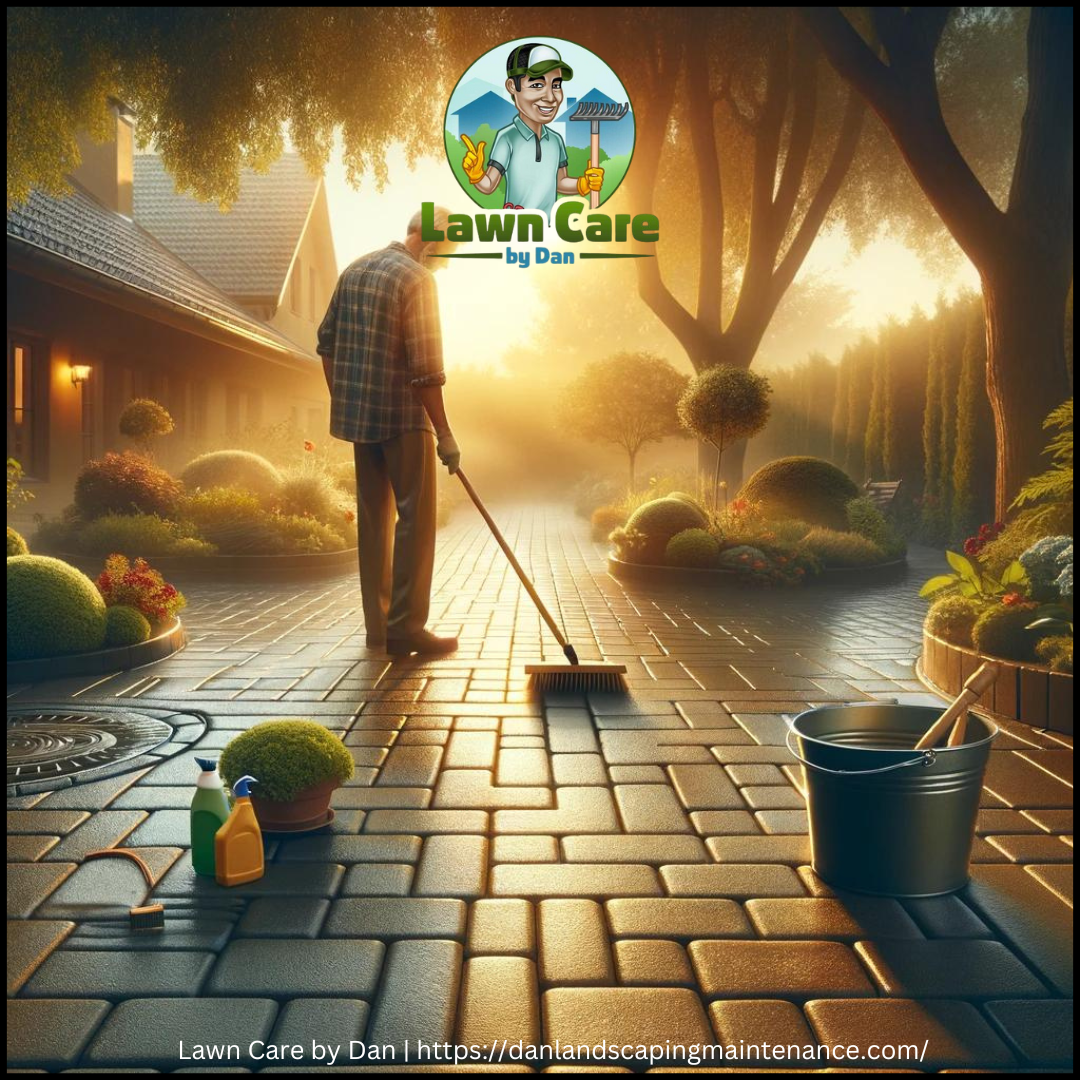
- Regular Cleaning: Like any other area of your home, your patio needs regular cleaning to stay in top condition. Sweep your patio frequently to remove debris, such as leaves and dirt, that can stain your pavers over time. Wash your patio with a garden hose and a mild detergent for a deeper clean. For tougher stains, a pressure washer on a low setting can be effective, but be cautious, as too high of a pressure can damage the surface of the pavers.
- Weed and Moss Removal: Despite your best efforts in installation, weeds, and moss can find their way between your pavers. Regularly pulling weeds and applying a natural weed killer can keep them at bay. For moss, a mixture of vinegar and water or a commercial moss remover can be applied. Follow up with polymeric sand to fill any gaps left behind, preventing future growth.
- Stain Prevention and Removal: Spills should be cleaned promptly to prevent staining. Use a cleaner specifically designed for paver stains for oil, grease, or other stubborn marks. Always test any cleaning solution on a small, inconspicuous area first to ensure it doesn’t discolor your pavers.
- Sealing Your Pavers: Sealing is not just for aesthetics; it’s a protective measure that can extend the life of your patio. A quality sealant repels water, reduces fading from UV light, and can make cleaning easier by preventing stains from penetrating the surface of the pavers. We recommend sealing your pavers every 2-3 years, depending on the level of exposure and wear.
- Addressing Movement and Settling: Over time, your pavers may shift or settle due to natural settling or erosion underneath. Regularly inspect your patio for unevenness or gaps. If you notice any issues, removing the affected pavers, releveling the base, and reinstalling them may be necessary. This is also an excellent time to replace any cracked or damaged pavers.
- Joint Sand Maintenance: The sand between your pavers plays a crucial role in the overall stability of your patio. Check the condition of the joint sand annually and reapply polymeric sand as needed. This will keep your pavers in place and help prevent weed growth and insect infestation.
- Winter Care: In colder climates, your paver patio will face the challenge of freezing temperatures and thaw cycles. Use a plastic shovel rather than metal to remove snow and avoid scratching the pavers. If using de-icing salts, choose a safe product for concrete pavers to prevent damage.
By following these care guidelines from Lawn Care By Dan Paver Patios, you can enjoy a beautiful and functional paver patio for many years. Regular maintenance keeps your patio looking its best and prevents minor issues from becoming major problems down the line. Remember, the key to a lasting paver patio is a little attention and care now and then.
Common Mistakes to Avoid
Creating a paver patio is an exciting project to enhance your outdoor living experience. However, the path to perfection is fraught with potential pitfalls. We underscore the importance of sidestepping common mistakes to ensure your patio project is successful and enduring. Here are some critical missteps to avoid:
- Underestimating the Importance of a Proper Foundation: One of the most critical aspects of patio installation is preparing a solid foundation. Skimping on this step can lead to pavers shifting, sinking, or becoming uneven over time. Ensure your base layer is of the correct thickness, adequately compacted, and made of the right material for your soil type and climate.
- Neglecting Proper Drainage: Failing to plan for adequate drainage can lead to water pooling on or around your patio, damaging the structure over time. Ensure your patio has a slight slope away from your home, and consider incorporating drainage solutions such as French drains or permeable pavers if necessary.
- Choosing the Wrong Pavers: It is a mistake to select pavers solely based on aesthetics without considering their suitability for our climate here in the Pacific Northwest, the traffic they will endure, and their maintenance requirements. Research or consult with professionals like Lawn Care By Dan Paver Patios to find the best type of paver for your specific needs.
- Improper Paver Installation: Laying pavers without ensuring they are level and properly aligned can result in an unsightly and unstable patio. Take the time to lay each paver carefully, use a level to check your work, and don’t rush the process.
- Overlooking the Edge Restraints: Edge restraints are crucial for keeping your pavers in place. Without them, your patio could slowly spread out and lose its shape. Ensure you install a durable edge restraint system around the perimeter of your patio.
- Ignoring Maintenance: Even the best-installed patio will require some maintenance to keep it looking its best. Failing to clean, re-sand joints, and seal your pavers periodically can lead to deterioration. Regular maintenance keeps your patio beautiful and extends its lifespan.
- DIY Overconfidence: While it’s possible to install a paver patio as a DIY project, underestimating the complexity of the task can lead to disappointing results. If you’re not confident in your ability to prepare the site, lay the pavers correctly, and address potential issues like drainage, consider hiring professionals like Lawn Care By Dan Paver Patios.
- Not Planning for the Future: Consider your future needs and potential changes to your landscape or outdoor living requirements. Installing a patio without considering future additions or changes can limit your options. Leave room for expansion or additional features such as a fire pit, outdoor kitchen, or seating walls.
By avoiding these common mistakes, you can ensure your patio project goes smoothly, resulting in a beautiful, durable outdoor living space. Remember, the key to a successful patio lies in careful planning, attention to detail, and regular maintenance. With these principles in mind and Lawn Care By Dan Paver Patios’s expertise at your disposal, you’re well on your way to creating an outdoor space you’ll enjoy for years.
Why Lawn Care By Dan Paver Patios?
Transforming your outdoor space into a stunning and durable paver patio doesn’t have to be a daunting task. You can create an enchanting retreat that enhances your home and lifestyle with the proper planning, materials, and care. However, achieving that perfect balance of beauty, functionality, and longevity requires expertise and attention to detail.
This is where Lawn Care By Dan Paver Patios comes in. Our team of experienced professionals is dedicated to bringing your patio dreams to life. We understand the nuances of patio design and installation, from selecting the ideal materials to ensuring a flawless execution. By choosing Lawn Care By Dan Paver Patios, you’re not just getting a patio but investing in a space that will host countless memories for years.
Don’t let common mistakes or installation complexities deter you from achieving the outdoor space you’ve always wanted. Whether starting from scratch or revitalizing an existing patio, we are here to guide you every step of the way. Let us help you avoid the pitfalls and navigate the journey to a perfect patio easily and confidently.
Ready to transform your outdoor living space? Contact Lawn Care By Dan Paver Patios today to schedule a consultation. We’ll design a patio that meets your needs and exceeds your expectations. Your dream patio awaits – let’s make it a reality.


